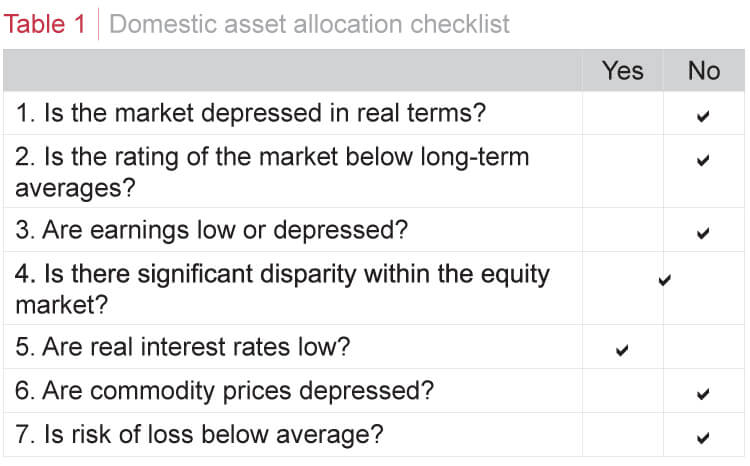I recently read the fascinating book ‘The Success Equation: Untangling luck in Business, Sports and Investing’, which explores, how much of one’s success or failure can be attributed to luck as opposed to skill (leading to much reflection). Investing, as the author points out, by its very nature involves a fair amount of luck compared to other activities, which are less probabilistic. For example, if I had to race Usain Bolt over 100m he would beat me 100% of the time, whereas if we both picked stocks he would have a relatively higher success rate than my zero.
The one story in the book that really stuck with me was the potential importance of checklists and how a simple checklist proposed by a specialist at Johns Hopkins Hospital, significantly reduced fatalities from infection during surgery in the US, despite initial opposition from surgeons.
A simple checklist for thinking about the appropriate weighting to local equities may look something like Table 1.

The justification for the placing of the ticks:
1. The FTSE/JSE All Share Index (ALSI) in inflation-adjusted (real)terms is far from depressed and is trading well above its long-term trend line. This is very different from 2003 or in the late 1970s when the market had gone nowhere for years. Over the last decade equities have returned 2.9x more than cash, whereas in the previous decade(1993 to 2003), equities underperformed cash.
2. The ALSI’s current price to earnings ratio (PE) is 16.9, versus its long-term average of 12. The PE rises close to 20 when using a more sustainable level of earnings. Even if we ignore earnings and use a price to net asset value (NAV) measure, the current ratio is 2.6, versus a long-term average of 2.1x.
3. Aggregate real earnings for stocks listed on the ALSI are at elevated levels and well above their own long-term trend.
4. Significant disparity in the market allows investors to allocate a high percentage to equities even if the overall market is expensive, as there are enough cheap shares to build the position. For example, in 2002, even though we believed the market was expensive, we had a high equity weighting as local industrial and consumer shares were exceptionally cheap. Today we have less conviction despite the large underperformance of mining shares. Please see our previous commentaries (for example, Quarterly Commentary 1, 2011 and Quarterly Commentary 2, 2011) for a discussion on the difficulties in valuing local mining shares and our concerns over the sustainability of China’s effect on commodity demand. So the tick goes in the middle.
5. Interest rates on local cash are below the level of inflation i.e. real interest rates are negative. This presents a dilemma for savers, but does it mean you have to buy shares as is argued by many investment commentators? It would appear to make intuitive sense, but history suggests it is wrong. Graph 1 is a scatter plot diagram highlighting the subsequent four-year real returns achieved by investing in equities at the different levels of real interest rates that have prevailed over the last 43 years. One can immediately see there is virtually no correlation between the level of real interest rates and the subsequent four-year return from shares. In fact, it appears to be better to buy shares when real interest rates are high. Equities may outperform when real interest rates are negative, but the real determinant of outperformance is whether or not the shares were cheap at the time of purchase, regardless of the level of interest rates.

6. Commodity prices are extremely important to South Africa given the pervasive effect they seem to have on our economic growth. While the basket of commodities sold by the major mining companies has fallen from its peak, they are far from obviously depressed.
7. Assuming market history is representative of what we can expect in the future, and I don’t see why it should not be, a simple review of the checklist suggests it is difficult to argue for a high equity weighting within asset allocation funds.
Nonetheless, it is incredibly difficult to forecast the future. Being correct involves an element of luck, which is why we place so much emphasis on our investment process; we hope to reduce the contribution of luck as much as possible.
Allan Gray Proprietary Limited is an authorised financial services provider. The FTSE/JSE Africa Index Series is calculated by FTSE International Limited (FTSE) in conjunction with the JSE Limited (JSE) in accordance with standard criteria. The FTSE/JSE Africa Index Series is the proprietary information of FTSE and the JSE. All copyright subsisting in the FTSE/JSE Africa Index Series index values and constituent lists vests in FTSE and the JSE jointly. All their rights are reserved.